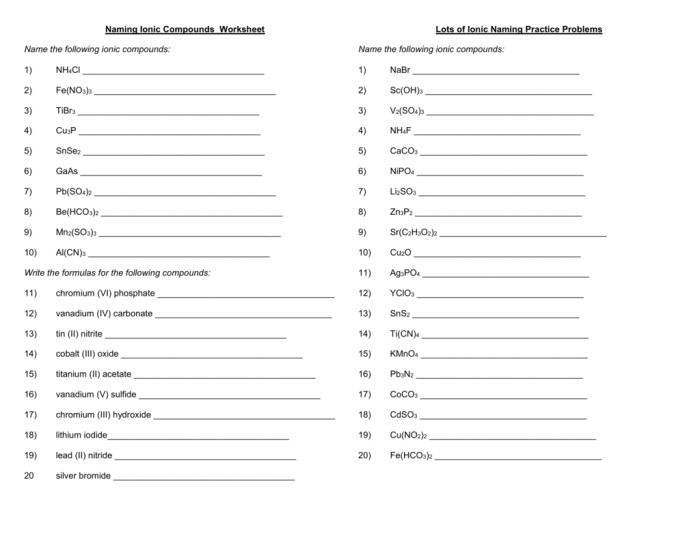Names and formulas of ionic compounds worksheet – Embark on a captivating journey into the realm of ionic compounds with our comprehensive worksheet, “Names and Formulas of Ionic Compounds.” This meticulously crafted resource empowers you to unravel the secrets of naming and formula writing, unlocking a deeper understanding of these fundamental chemical entities.
Delve into the intricacies of ionic nomenclature, unraveling the rules that govern the naming of these compounds based on their constituent elements. Explore the systematic approach to formula writing, guided by the charges of the participating ions. Prepare to conquer a series of engaging exercises designed to reinforce your comprehension and solidify your mastery.
Names of Ionic Compounds: Names And Formulas Of Ionic Compounds Worksheet
Ionic compounds are formed by the electrostatic attraction between positively charged ions (cations) and negatively charged ions (anions). The names of ionic compounds are derived from the names of the constituent elements.
To name an ionic compound, the name of the cation is written first, followed by the name of the anion. For example, the ionic compound formed between sodium (Na+) and chlorine (Cl-) is called sodium chloride (NaCl).
There are a few exceptions to the rules for naming ionic compounds. For example, the cation of lead (Pb) is named plumbum, and the anion of oxygen (O) is named oxide.
Formulas of Ionic Compounds

The formulas of ionic compounds are written using the chemical symbols of the constituent elements. The subscript after each symbol indicates the number of atoms of that element in the compound. For example, the formula for sodium chloride is NaCl, which indicates that there is one sodium atom and one chlorine atom in each molecule of sodium chloride.
The charges of the ions are not explicitly written in the formula of an ionic compound. However, the charges can be determined by using the periodic table. For example, sodium is in Group 1 of the periodic table, which means that it has one valence electron.
When sodium loses this electron, it forms a cation with a charge of +1. Chlorine is in Group 17 of the periodic table, which means that it has seven valence electrons. When chlorine gains one electron, it forms an anion with a charge of -1.
Worksheet Activities
Worksheet 1: Naming Ionic Compounds, Names and formulas of ionic compounds worksheet
- Name the following ionic compounds:
- NaCl
- CaO
- Al2O3
- Write the names of the following cations:
- Na+
- Ca2+
- Al3+
- Write the names of the following anions:
- Cl-
- O2-
- N3-
Worksheet 2: Writing the Formulas of Ionic Compounds
- Write the formulas of the following ionic compounds:
- Sodium chloride
- Calcium oxide
- Aluminum oxide
- Write the formulas of the following cations:
- Sodium
- Calcium
- Aluminum
- Write the formulas of the following anions:
- Chloride
- Oxide
- Nitride
FAQ
What are ionic compounds?
Ionic compounds are formed when a metal loses one or more electrons to a non-metal, resulting in the formation of positively charged cations and negatively charged anions.
How do I name ionic compounds?
To name an ionic compound, first identify the cation and anion. The cation is named first, followed by the anion. For example, NaCl is named sodium chloride.
How do I write the formula for an ionic compound?
To write the formula for an ionic compound, first determine the charges of the cation and anion. Then, balance the charges by using subscripts. For example, the formula for sodium chloride is NaCl.

